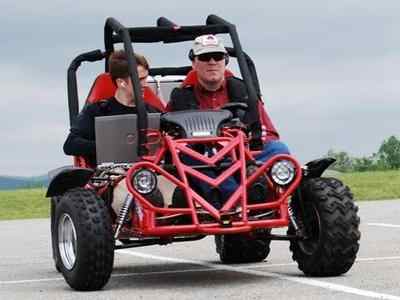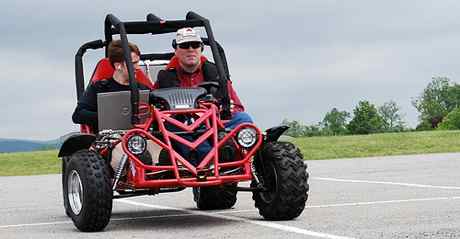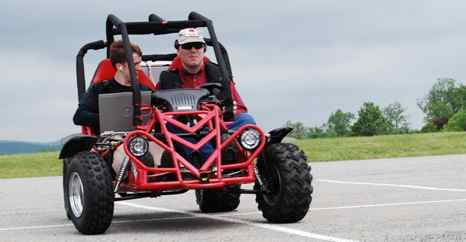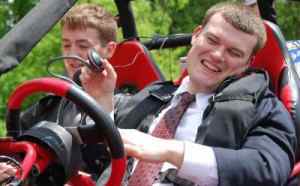盲目の人が運転できる・・
ついに盲目の人でも運転できる車が作られる
2009年07月25日 22:01

近年、無人で自動的に運転するテクノロジーが研究されていますが、それをを応用して画期的な車が考案されたました。
バージニア工科大学の学生が、目が不自由でも運転できる車を作り上げたそうです。
車にはレーザーや音声その他に反応するセンサーを搭載し、スムーズに動いたそうです。
盲目の人が独立した生活を営むための、きっかけになるのではと車だけでなく、さらなる可能性にも注目しているようです。
もともとは2004年にジェーニガン盲人協会が、目の不自由な人向けの自動車を開発することはできないかと持ちかけたもので、バージニア工科大学がそれに応じて研究が始りました。
開発にあたって3000ドル(約28万円)の融資を受け、新しい挑戦が始まりました。バギーを組み立て、レーザーファインダーから集められた情報をハンドルのモニターにリンクさせ、音声ガイダンスが運転手にどれくらいハンドルを切らなければいけないかを伝えるそうです。
スピードの増減は胴着に振動で伝え、振動箇所によって指示を判別するそうです。
まだ開発の初期段階ではありますが、来年度の学生がこれを受け継いでさらなる改良を加えていく予定です。
現在は法的にも盲人による運転は禁止されていますが、安全性に対する一般の認識などを少しずつ変えていく助けになればと考えているようです。
将来、目の不自由な人が運転可能かどうかはさておき、あえて困難なことにチャレンジする精神こそが、生活を向上させていくことへと繋がっていくのでしょうね。
Students Build a Car the Blind Can Drive
Posted by John in Science & Tech on July 24, 2009 at 2:02 pm

Engineering students at Virginia Tech have built a car that can be driven by the visually impaired. The vehicle is equipped with laser range finders and a semi-autonomous computer that helps direct drivers around a course that they can’t see:
The steering wheel is hooked up to a distance monitor that gathers information from laser range finders, and it uses voice software to tells the driver how far to turn the wheel. For example, the monitor will tell the driver “turn left three clicks.” As the driver does that, the monitor makes three clicking noises.
A vibrating vest provides cues to follow when accelerating and decelerating. The vest vibrates in different places — the back, the belly and the shoulders — to convey different commands. When the entire vest vibrates, it means, “Slam on the brakes!”
Students Build a Car the Blind Can Drive
By Ben Mack July 23, 2009 | 6:17 pm | Categories: Cool Cars

The same technology that lets cars drive themselves allows the blind to drive, too.
Virginia Tech undergrads packed an all-terrain buggy with technology lifted from the university’s DARPA Urban Challenge entry to create a car the blind can drive. The semi-autonomous vehicle uses a laser range finder, voice software and other sensory technology, and it worked flawlessly when blind drivers took the wheel on a closed course. Advocates for the blind joined the lead researcher in calling the vehicle a breakthrough in independent living for the visually impaired.
“We are not only excited about the vehicle itself, but also the potential spinoff technologies from this project that could end up helping the blind,” Dennis Hong, the director of the university’s Robotics and Mechanisms Laboratory, told Wired.com.

Wes Majerus, who is blind, called the car "a great first step" after taking it for a spin.
The car was born of a challenge the National Federation of the Blind’s Jernigan Institute issued in 2004 when it called on universities to develop a vehicle for the blind. Virginia Tech accepted the challenge in 2006 — the only university to do so — and received a $3,000 grant to begin the project.
The Blind Driver Challenge team at Virginia Tech’s Robotics and Mechanisms Laboratory built the buggy. The steering wheel is hooked up to a distance monitor that gathers information from laser range finders, and it uses voice software to tells the driver how far to turn the wheel. For example, the monitor will tell the driver “turn left three clicks.” As the driver does that, the monitor makes three clicking noises.
A vibrating vest provides cues to follow when accelerating and decelerating. The vest vibrates in different places — the back, the belly and the shoulders — to convey different commands. When the entire vest vibrates, it means, “Slam on the brakes!”
“Originally we had a vibrating chair, but the vehicle was also vibrating on account of the motor, so drivers had some difficulty differentiating between the two,” Hong said. “The 2009-2010 team will be applying this technology to an electric vehicle to eliminate the vibration caused by the motor altogether.”
Hong wants to continue working on a tactile map interface. The system, called Airpix, shoots compressed air through tiny holes on a screen in real time, to provide a layout of the area surrounding the vehicle. Drivers can “read” the map with a hand, much like Braille. Hong said he needs more feedback from the blind and visually impaired to refine the system.
All this technology is clearly in its earliest stage,s and we’re a long way from the day when the blind join us in slogging through the morning commute. But the Federation for the Blind hailed the vehicle and the promise it offers.
“It’s a great first step,” Wes Majerus, an access-technology expert for the federation, said in a press release. “As far as the differences between human instructions and those given by the voice in the Blind Driver Challenge car, the car’s instructions are very precise. You use the technology to act on the environment — the driving course — in a very orderly manner.”
Majerus drove the car and said, “It was great.” Mark Riccobono, executive director of the Jernigan Institute, called his test drive historic. “This is sort of our going-to-the-moon project,” he said.
Although the technology is progressing, laws prohibiting the blind from driving — not to mention public perception about that possibility — must be changed, Hong said. That is why the Blind Driver’s Challenge team will be promoting the vehicle’s technology at a National Federation for the Blind–sponsored parade in Washington, D.C.
“People always say, ‘What’s the point of this project?’” Hong said. “But blind people who drive the vehicle always have a big smile on their face afterwards. It’s therapeutic and gives them hope of being entirely independent.”
Photos: Virginia Tech
